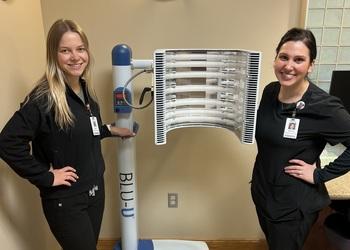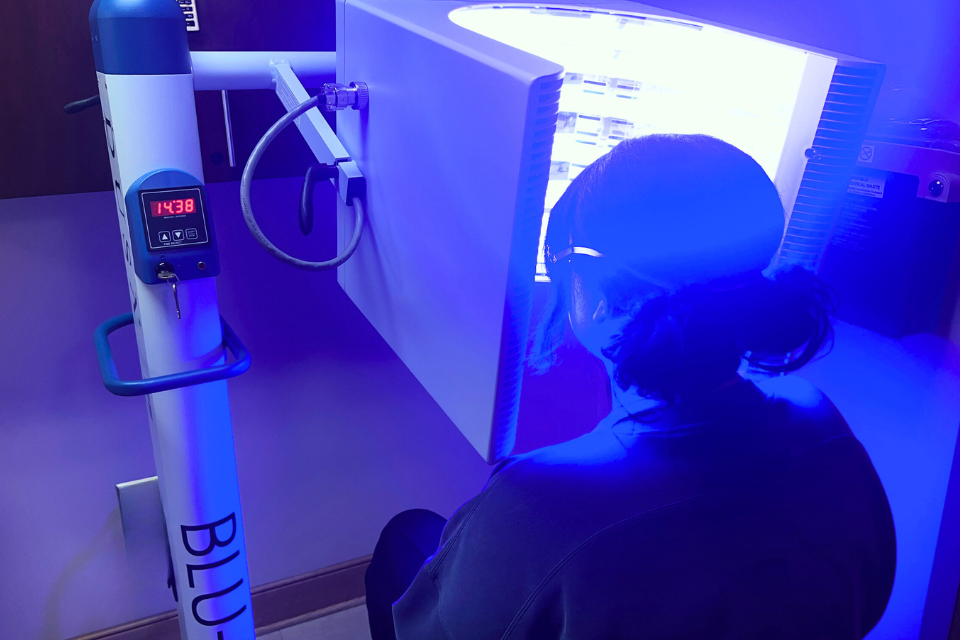Blue light therapy, also known as photodynamic therapy, is a type of light treatment that’s used to treat diseased or damaged skin. It uses medications called photosensitizing agents along with specific wavelengths of blue light to destroy abnormal skin cells while leaving the surrounding tissue unharmed. Blue light therapy involves an initial screening followed by a treatment visit.
What can blue light therapy treat?
Dermatologists frequently refer their patients for blue light therapy to prevent skin cancer and treat precancerous and cancerous skin growths. The FDA has approved photodynamic therapy for the treatment of actinic keratosis, a type of pre-cancer that develops on the skin from years of exposure to the sun. Actinic keratoses appear as rough, scaly patches on the skin that may be light or dark tan, flesh-toned, red, or white in color. Photodynamic therapy is an optimal treatment for anyone who has multiple lesions since they can all be treated at once. If left untreated, an estimated 10 percent of these precancerous lesions may eventually evolve into a type of skin cancer called squamous cell carcinoma.
What happens during a blue light treatment session?
The blue light treatment session consists of three steps.
- During the first step, your provider applies the photosensitizing agent to your skin. This is the medication that makes certain types of skin tissue, such as precancerous lesions, more susceptible to the absorption of light wavelengths used during treatment.
- After the photosensitizing agent is applied, you’ll begin the second stage of the treatment process, called the incubation period. During this step, the photosensitizing medication is absorbed into your skin. Depending on the area being treated, this step can take several hours.
- Once the compound has been absorbed, blue light is applied. During the blue light exposure, you might feel a mild tingling or burning sensation, but this is only temporary. Rest assured that a trained registered nurse will remain in the room with you during your light treatment have you any questions or discomfort they will be present to assist you. Exposure to blue light causes a reaction in the skin, destroying the targeted skin tissue. The blue light only targets the tissues that absorbed the photosensitizing medication.

Our skilled board-certified Truyu Dermatology team will design a treatment plan that ensures the best possible results. During your follow-up exam, your provider will examine your skin to make sure that you’re healing well and that the desired results have been achieved. At this time, we’ll discuss whether you need any more treatments. If you don’t require any additional treatments, your dermatology provider will recommend a checkup once a year to ensure that your skin is healthy and identify any signs of concern that may indicate future maintenance treatments.
What can I expect after blue light skin treatment?
After blue light skin treatment, your skin will be very sensitive, and you may experience skin redness and swelling. Your skin may also peel or appear flaky, similar to the way it looks after a sunburn. These effects are only temporary and will subside over a period of a few days to a week. To alleviate swelling, you can apply ice or cold packs to the treated area.
Your dermatologist will recommend avoiding the sun or any exposure to bright light for at least 48 hours after treatment. This is because the photosensitizing medication makes your skin very sensitive to the sun, increasing your risk of a severe sunburn. After 48 hours have passed, you can resume your everyday activities, although you should wear sunscreen during any time spent outdoors.
Schedule an appointment online or call 701.780.6623 to book your screening.


